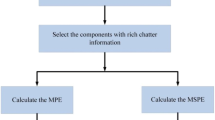Abstract
Machining chatter is the self-excited vibration between the cutting tool and work piece that can deteriorate surface quality and increase cost. A reliable machining chatter forecast method is needed to recognize chatter symptom, while the chatter is developing. In this paper, an online machining chatter forecast framework is proposed. The improved moving average algorithm is designed to improve the performance of the local mean decomposition (LMD) method in dealing with non-stationary force and vibration signals. According to the result of signal character analysis, some sensitive features are extracted to build characteristic vectors. A machining chatter forecast model is put forward based on the hidden Markov model (HMM). The Viterbi algorithm is used to resolve the optimum cutting transient sequence. The mapping relationship between vector sequences in the input space and images in the pattern space has been developed based on the posterior transient transform probability. An experimental platform has been implemented to illustrate and validate the proposed method. Case studies showed that machining chatter could be forecasted effectively in advance during its developing stage. Quantitative analysis and comparison verified that both the precision and timeliness could be improved.
Similar content being viewed by others
References
Altintas Y, Budak E (1995) Analytical prediction of stability lobes in milling. CIRP Ann Manuf Technol 44(1):357–362
Siddhpura M, Paurobally R (2012) A review of chatter vibration research in turning. Int J Mach Tool Manuf 61:27–47
Budak E, Altintas Y (1998) Analytical prediction of chatter stability in milling-part I: general formulation. J Dyn Sys Meas Con Trans ASME 120(1):22–30
Wan M, Ma YC, Zhang WH, Yang Y (2015) Study on the construction mechanism of stability lobes in milling process with multiple modes. Int J Adv Manuf Technol. doi:10.1007/s00170-015-6829-4
Zhou X, Zhang DH, Luo M, Wu BH (2015) Chatter stability prediction in four-axis milling of aero-engine casings with bull-nose end mill. Chine J Aeron. doi:10.1016/j.cja.2015.06.001
Urbikain G, Olvera D, Lacalle LN, Elías-Zúñiga A (2015) Stability and vibrational behaviour in turning processes with low rotational speeds. Int J Adv Manuf Technol. doi:10.1007/s00170-015-7041-2
Li ZQ, Liu Q, Ming XZ, Wang X, Dong YF (2014) Cutting force prediction and analytical solution of regenerative chatter stability for helical milling operation. Int J Adv Manuf Technol 73:433–442
Yang YQ, Liu Q, Zhang B (2014) Three-dimensional chatter stability prediction of milling based on the linear and exponential cutting force mode. Int J Adv Manuf Technol 72:1175–1185
Graham E, Mehrpouya M, Nagamune R, Park SS (2014) Robust prediction of chatter stability in micro milling comparing edge theorem and LMI. CIRP J Manuf Sci Technol 7:29–39
Cao HR, Lei YG, He ZJ (2013) Chatter identification in end milling process using wavelet packets and Hilbert–Huang transform. Int J Mach Tool Manuf 69:11–19
Cao HR, Zhou K, Chen XF (2015) Chatter identification in end milling process based on EEMD and nonlinear dimensionless indicators. Int J Mach Tool Manuf 92:52–59
Thaler T, Potocnik P, Bric I, Govekar E (2014) Chatter detection in band sawing based on discriminant analysis of sound features. App Acou 77:114–121
Tangjitsitcharoen S, Pongsathornwiwat N (2013) Development of chatter detection in milling processes. Int J Adv Manuf Technol 65:919–927
Rafal R, Pawel L, Krzysztof K, Bogdan K, Jerzy W (2015) Chatter identification methods on the basis of time series measured during titanium super alloy milling. Inter J Mech Sci 99:196–207
Kang J, Feng CJ, Shao Q, Hu HY (2007) Prediction of chatter in machining process based on hybrid SOM-DHMM Architecture. Adv Intel Comp Theor Appli 4682:1004–1013
Kang J, Feng CJ, Hu HY, Shao Q (2007) Research on Chatter prediction and monitor based on DHMM pattern recognition theory. In: Proceedings of the IEEE International Conference on Automation and Logistics. Jinan, 1368–1372
Mei DQ, Li X, Chen ZC (2007) Prediction of cutting chatter based on hidden Markov model. Key Eng Mater 353–358:2712–2715
Zhang CL, Chen LP (2006) Real time monitoring of cutting chatter based on fuzzy hidden Markov models. Mater Sci For 532–533:1160–1163
Hynynen KM, Ratava J, Lindh T, Rikkonen M, Ryynanen V, Lohtander M, Varis J (2014) Chatter detection in turning processes using coherence of acceleration and audio signals. J Manuf Sci Eng 136(4):044503
Zhang HT, Wu Y, He DF, Zhao H (2015) Model predictive control to mitigate chatters in milling processes with input constraints. Int J Mach Tool Manuf 91:54–61
Author information
Authors and Affiliations
Corresponding author
Rights and permissions
About this article
Cite this article
Sun, H., Zhang, X. & Wang, J. Online machining chatter forecast based on improved local mean decomposition. Int J Adv Manuf Technol 84, 1045–1056 (2016). https://doi.org/10.1007/s00170-015-7785-8
Received:
Accepted:
Published:
Issue Date:
DOI: https://doi.org/10.1007/s00170-015-7785-8




